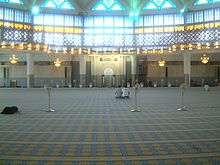Perihal MASJID NEGARA
Nostalgik..selalu pergi ketika ada Majlis Maulidurasul perarakan dan ceramah agama..termasuk Allayarham HAMKA..pernah menyampaikan ceramah di sini...
National Mosque of Malaysia
From Wikipedia, the free encyclopedia


| National Mosque Masjid Negara مسجد نݢارا 国家清真寺 தேசிய பள்ளிவாசல் |
|
|---|---|

The National Mosque of Malaysia in Kuala Lumpur
|
|
| Basic information | |
| Location | Kuala Lumpur, Malaysia[1] |
| Affiliation | Sunni |
| Architect(s) | Howard Ashley, Hisham Albakri and Baharuddin Kassim |
| Architectural style | Modern |
| Completed | 1965 |
| Capacity | 15,000 |
| Minaret height | 73 m |
| Materials | concrete |
 MISSING PARAM: ownership Malaysian government
MISSING PARAM: ownership Malaysian government
Minaret of the National Mosque
An inside view of the National Mosque of Malaysia
Friday prayer inside main prayer hall
A structure part of the mosque
Its key features are a 73-metre-high minaret and a 16-pointed star concrete main roof. The umbrella, synonymous with the tropics, is featured conspicuously – the main roof is reminiscent of an open umbrella, the minaret's cap a folded one. The folded plates of the concrete main roof are a creative solution to achieving the larger spans required in the main gathering hall. Reflecting pools and fountains spread throughout the compound.
Contents
History
The mosque underwent major renovations in 1987, and the once-pink concrete roof is now clad in green and blue tiles. Today, Masjid Negara continues to stand sleek and stylish against the Kuala Lumpur skyline. An underground passage leads to the National Mosque located near the railway station, along Jalan Sultan Hishamuddin. Its unique modern design embodies a contemporary expression of traditional Islamic art calligraphy and ornamentation. Near the mosque is the Makam Pahlawan (Heroes' Mausoleum), a burial ground of several Malaysian muslim leaders. Makam Pahlawan is a 7-pointed star concrete roofed structure.
On 27 August 2015, Masjid Negara celebrates its Golden Jubilee (50 anniversary).
Imams of Masjid Negara
- Haji Ghazali Abdullah (1965)
- Hj. Mohd Salleh Hassan Farid
- Datuk Sheikh Abdul Mohsein bin Hj. Salleh (1974-1975)
- Dato' Hj. Ahmad Shahir bin Haji Daud (1975-1980)
- Dato' Hj. Abu Hassan bin Din Al-Hafiz (1981-1983)
- Dato' Hj. Ahmad Shahir bin Haji Daud (1984-1992)
- Haji Arifin Harun (1992-1993)
- Dato' Hj. Taib Azamudden bin Md. Taib (1993-1999)
- Haji A. Jalil bin Sindring @ Prangerang (1999-Sep. 2001)
- Haji Wan Halim bin Wan Harun (2001-2004)
- Dato' Haji Kamaruddin bin Hj Zakaria (2005-2006)
- Tan Sri Dato' Syaikh Hj.Ismail bin Hj.Muhammad (February 2007-present)

No comments:
Post a Comment